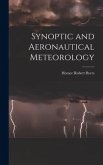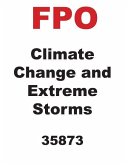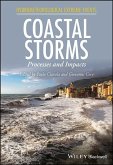The Oxford Handbook of Non-Synoptic Wind Storms
Herausgeber: Hangan, Horia; Kareem, Ahsan
The Oxford Handbook of Non-Synoptic Wind Storms
Herausgeber: Hangan, Horia; Kareem, Ahsan
- Gebundenes Buch
- Merkliste
- Auf die Merkliste
- Bewerten Bewerten
- Teilen
- Produkt teilen
- Produkterinnerung
- Produkterinnerung
Worldwide, much of the damage due to wind is caused by non-synoptic, local wind storm events, such as tornadoes and downbursts. The need is clear to better understand non-synoptic local winds; properly simulate them; assess the difference in loading between these events and synoptic large-scale winds; determine their statistics and associated risks; and apply this through guidelines, codes, risk mitigation, and adaptation responses to socioeconomic impact. This Handbook features a cohesive collection of 25 articles, contributed by leading scientists, scholars, and engineers. Together, they…mehr
Andere Kunden interessierten sich auch für
![Synoptic Climatology in Environmental Analysis Synoptic Climatology in Environmental Analysis]() Brent YarnalSynoptic Climatology in Environmental Analysis572,99 €
Brent YarnalSynoptic Climatology in Environmental Analysis572,99 €![The Sailor's Horn-Book for the Law of Storms The Sailor's Horn-Book for the Law of Storms]() Henry PiddingtonThe Sailor's Horn-Book for the Law of Storms40,99 €
Henry PiddingtonThe Sailor's Horn-Book for the Law of Storms40,99 €![Synoptic-Dynamic Meteorology and Weather Analysis and Forecasting: A Tribute to Fred Sanders Volume 33 Synoptic-Dynamic Meteorology and Weather Analysis and Forecasting: A Tribute to Fred Sanders Volume 33]() Synoptic-Dynamic Meteorology and Weather Analysis and Forecasting: A Tribute to Fred Sanders Volume 33128,99 €
Synoptic-Dynamic Meteorology and Weather Analysis and Forecasting: A Tribute to Fred Sanders Volume 33128,99 €![Synoptic and Aeronautical Meteorology Synoptic and Aeronautical Meteorology]() Horace Robert ByersSynoptic and Aeronautical Meteorology36,99 €
Horace Robert ByersSynoptic and Aeronautical Meteorology36,99 €![Predicting Storms Predicting Storms]() Robert EllisPredicting Storms35,99 €
Robert EllisPredicting Storms35,99 €![Climate Change and Extreme Storms Climate Change and Extreme Storms]() Mary DykstraClimate Change and Extreme Storms32,99 €
Mary DykstraClimate Change and Extreme Storms32,99 €![Coastal Storms Coastal Storms]() Coastal Storms132,99 €
Coastal Storms132,99 €-
-
-
Worldwide, much of the damage due to wind is caused by non-synoptic, local wind storm events, such as tornadoes and downbursts. The need is clear to better understand non-synoptic local winds; properly simulate them; assess the difference in loading between these events and synoptic large-scale winds; determine their statistics and associated risks; and apply this through guidelines, codes, risk mitigation, and adaptation responses to socioeconomic impact. This Handbook features a cohesive collection of 25 articles, contributed by leading scientists, scholars, and engineers. Together, they provide clear definitions of the problems to be tackled, identify the best-suited tools and methodologies to address them, suggest ways to maximize collaborative planning, and offer a strategic framework for forward-looking research.
Produktdetails
- Produktdetails
- Verlag: Oxford University Press, USA
- Seitenzahl: 648
- Erscheinungstermin: 31. August 2021
- Englisch
- Abmessung: 249mm x 180mm x 49mm
- Gewicht: 1143g
- ISBN-13: 9780190670252
- ISBN-10: 0190670258
- Artikelnr.: 62081110
- Verlag: Oxford University Press, USA
- Seitenzahl: 648
- Erscheinungstermin: 31. August 2021
- Englisch
- Abmessung: 249mm x 180mm x 49mm
- Gewicht: 1143g
- ISBN-13: 9780190670252
- ISBN-10: 0190670258
- Artikelnr.: 62081110
Horia Hangan is a Professor in the Faculty of Engineering and the Director of the Wind Engineering, Energy and Environment (WindEEE) Research Institute at the University of Western Ontario, Canada. His research focuses on the simulation and impact of weather systems on man-made or natural habitats. Ahsan Kareem is the Robert M. Moran Professor of Engineering and the Director of the NatHaz Modeling Laboratory at the University of Notre Dame. His work focuses on probabilistic characterization and formulation of dynamic load effects due to wind, waves and earthquakes on structures via fundamental experimental, laboratory and full-scale experiments utilizing cyber and cyber-physical infrastructures to enhance their safety.
* Foreword
* Julian Hunt
* Section 1 - Introduction: Non-Synoptic Wind Storms
* 1. Introduction
* Horia Hangan and Ahsan Kareem
* 2. The Types of Non-Synoptic Wind Systems
* Howard B. Bluestein
* 3. Engineering Perspective of Tornadoes
* Kishor C. Mehta
* 4. Ground-Breaking Contributions to Downburst Monitoring, Modeling,
and Detection
* Massimiliano Burlando and Djordje Romanic
* 5. Characteristics of Downslope Windstorms in the View of the Typical
Atmospheric Boundary Layer
* Hrvoje Kozmar and Branko Grisogono
* 6. Forecasting of Tornadoes and Downbursts: Challenges,
Prioritization, and Progress
* Djordje Romanic
* 7. Potential Effects of Anthropogenic Climate Change on Non-Synoptic
Wind Storm Hazards
* Robert J. Trapp
* Section 2 - In Situ Data Acquisition for NSWS
* 8. Measuring the Engineering-Relevant Aspects of Non-Synoptic Wind
Hazards
* John L. Schroeder
* 9. Non-Synoptic Winds Data Basis
* Uwe Ulbrich and Edmund P. Meredith
* Section 3 - Modeling Methods for NSWS
* 10. Analytical and Semi-empirical Models of Tornadoes and Downbursts
* Djordje Romanic and Horia Hangan
* 11. Mesoscale, Microscale, and Numerical Models: Limitations and
Future Evolution
* Patrick Hawbecker
* 12. Novel Physical Simulators for NSWS: Limitations and Future
Evolution
* Horia Hangan, Maryam Refan, Partha P. Sarkar, and Delong Zuo
* 13. Relation between Full Scale and Model Data
* Horia Hangan, Maryam Refan, and Djordje Romanic
* 14. Other Models: Data-Driven Approaches for Non-Stationary
Non-Synoptic Winds
* Dae Kun Kwon and Ahsan Kareem
* Section 4 -Structural and Other Impacts of NSWS
* 15. Aerodynamic Loading Due to Non-Synoptic Wind Systems
* Jubayer Chowdhury and Teng Wu
* 16. Extremely Gusty Winds from a Viewpoint of Aerodynamic Force
* Junji Maeda, Takashi Takeuchi, Eriko Tomokiyo, and Yukio Tamura
* 17. Structural Response to Non-Stationary Thunderstorm Outflows
* Dae Kun Kwon, Giovanni Solari, and Ahsan Kareem
* 18. Assessing Wind Damage to Residential Structures
* Timothy P. Marshall and J. Arn Womble
* 19. Numerical Simulation of Flight and Impact of Wind-borne Debris
* Takashi Nomura
* Section 5 - Risk Models Related To NSWS
* 20. Simplified Hazard Modeling and Structural Reliability Analysis
Considering Non-Synoptic Wind Systems (NSWS) in Canada
* Han Ping Hong and Qian Huang
* Section 6 - Reduction of Exposure to NSWS
* 21. Prediction of Non-Synoptic Wind Speeds
* Franklin T. Lombardo and Alexander S. Zickar
* 22. Towards the Codification of Thunderstorm/Downburst Winds
* Dae Kun Kwon, Ahsan Kareem, and Giovanni Solari
* 23. Economic and Policy Issues for Wind Resistant Construction
* Kevin M. Simmons
* 24. Convective Storms and the Insurance Industry: Challenges and
Opportunities
* Kirsten D. Orwig
* Section 7 - Conclusion
* 25. Concluding Summary
* Horia Hangan and Ahsan Kareem
* Julian Hunt
* Section 1 - Introduction: Non-Synoptic Wind Storms
* 1. Introduction
* Horia Hangan and Ahsan Kareem
* 2. The Types of Non-Synoptic Wind Systems
* Howard B. Bluestein
* 3. Engineering Perspective of Tornadoes
* Kishor C. Mehta
* 4. Ground-Breaking Contributions to Downburst Monitoring, Modeling,
and Detection
* Massimiliano Burlando and Djordje Romanic
* 5. Characteristics of Downslope Windstorms in the View of the Typical
Atmospheric Boundary Layer
* Hrvoje Kozmar and Branko Grisogono
* 6. Forecasting of Tornadoes and Downbursts: Challenges,
Prioritization, and Progress
* Djordje Romanic
* 7. Potential Effects of Anthropogenic Climate Change on Non-Synoptic
Wind Storm Hazards
* Robert J. Trapp
* Section 2 - In Situ Data Acquisition for NSWS
* 8. Measuring the Engineering-Relevant Aspects of Non-Synoptic Wind
Hazards
* John L. Schroeder
* 9. Non-Synoptic Winds Data Basis
* Uwe Ulbrich and Edmund P. Meredith
* Section 3 - Modeling Methods for NSWS
* 10. Analytical and Semi-empirical Models of Tornadoes and Downbursts
* Djordje Romanic and Horia Hangan
* 11. Mesoscale, Microscale, and Numerical Models: Limitations and
Future Evolution
* Patrick Hawbecker
* 12. Novel Physical Simulators for NSWS: Limitations and Future
Evolution
* Horia Hangan, Maryam Refan, Partha P. Sarkar, and Delong Zuo
* 13. Relation between Full Scale and Model Data
* Horia Hangan, Maryam Refan, and Djordje Romanic
* 14. Other Models: Data-Driven Approaches for Non-Stationary
Non-Synoptic Winds
* Dae Kun Kwon and Ahsan Kareem
* Section 4 -Structural and Other Impacts of NSWS
* 15. Aerodynamic Loading Due to Non-Synoptic Wind Systems
* Jubayer Chowdhury and Teng Wu
* 16. Extremely Gusty Winds from a Viewpoint of Aerodynamic Force
* Junji Maeda, Takashi Takeuchi, Eriko Tomokiyo, and Yukio Tamura
* 17. Structural Response to Non-Stationary Thunderstorm Outflows
* Dae Kun Kwon, Giovanni Solari, and Ahsan Kareem
* 18. Assessing Wind Damage to Residential Structures
* Timothy P. Marshall and J. Arn Womble
* 19. Numerical Simulation of Flight and Impact of Wind-borne Debris
* Takashi Nomura
* Section 5 - Risk Models Related To NSWS
* 20. Simplified Hazard Modeling and Structural Reliability Analysis
Considering Non-Synoptic Wind Systems (NSWS) in Canada
* Han Ping Hong and Qian Huang
* Section 6 - Reduction of Exposure to NSWS
* 21. Prediction of Non-Synoptic Wind Speeds
* Franklin T. Lombardo and Alexander S. Zickar
* 22. Towards the Codification of Thunderstorm/Downburst Winds
* Dae Kun Kwon, Ahsan Kareem, and Giovanni Solari
* 23. Economic and Policy Issues for Wind Resistant Construction
* Kevin M. Simmons
* 24. Convective Storms and the Insurance Industry: Challenges and
Opportunities
* Kirsten D. Orwig
* Section 7 - Conclusion
* 25. Concluding Summary
* Horia Hangan and Ahsan Kareem
* Foreword
* Julian Hunt
* Section 1 - Introduction: Non-Synoptic Wind Storms
* 1. Introduction
* Horia Hangan and Ahsan Kareem
* 2. The Types of Non-Synoptic Wind Systems
* Howard B. Bluestein
* 3. Engineering Perspective of Tornadoes
* Kishor C. Mehta
* 4. Ground-Breaking Contributions to Downburst Monitoring, Modeling,
and Detection
* Massimiliano Burlando and Djordje Romanic
* 5. Characteristics of Downslope Windstorms in the View of the Typical
Atmospheric Boundary Layer
* Hrvoje Kozmar and Branko Grisogono
* 6. Forecasting of Tornadoes and Downbursts: Challenges,
Prioritization, and Progress
* Djordje Romanic
* 7. Potential Effects of Anthropogenic Climate Change on Non-Synoptic
Wind Storm Hazards
* Robert J. Trapp
* Section 2 - In Situ Data Acquisition for NSWS
* 8. Measuring the Engineering-Relevant Aspects of Non-Synoptic Wind
Hazards
* John L. Schroeder
* 9. Non-Synoptic Winds Data Basis
* Uwe Ulbrich and Edmund P. Meredith
* Section 3 - Modeling Methods for NSWS
* 10. Analytical and Semi-empirical Models of Tornadoes and Downbursts
* Djordje Romanic and Horia Hangan
* 11. Mesoscale, Microscale, and Numerical Models: Limitations and
Future Evolution
* Patrick Hawbecker
* 12. Novel Physical Simulators for NSWS: Limitations and Future
Evolution
* Horia Hangan, Maryam Refan, Partha P. Sarkar, and Delong Zuo
* 13. Relation between Full Scale and Model Data
* Horia Hangan, Maryam Refan, and Djordje Romanic
* 14. Other Models: Data-Driven Approaches for Non-Stationary
Non-Synoptic Winds
* Dae Kun Kwon and Ahsan Kareem
* Section 4 -Structural and Other Impacts of NSWS
* 15. Aerodynamic Loading Due to Non-Synoptic Wind Systems
* Jubayer Chowdhury and Teng Wu
* 16. Extremely Gusty Winds from a Viewpoint of Aerodynamic Force
* Junji Maeda, Takashi Takeuchi, Eriko Tomokiyo, and Yukio Tamura
* 17. Structural Response to Non-Stationary Thunderstorm Outflows
* Dae Kun Kwon, Giovanni Solari, and Ahsan Kareem
* 18. Assessing Wind Damage to Residential Structures
* Timothy P. Marshall and J. Arn Womble
* 19. Numerical Simulation of Flight and Impact of Wind-borne Debris
* Takashi Nomura
* Section 5 - Risk Models Related To NSWS
* 20. Simplified Hazard Modeling and Structural Reliability Analysis
Considering Non-Synoptic Wind Systems (NSWS) in Canada
* Han Ping Hong and Qian Huang
* Section 6 - Reduction of Exposure to NSWS
* 21. Prediction of Non-Synoptic Wind Speeds
* Franklin T. Lombardo and Alexander S. Zickar
* 22. Towards the Codification of Thunderstorm/Downburst Winds
* Dae Kun Kwon, Ahsan Kareem, and Giovanni Solari
* 23. Economic and Policy Issues for Wind Resistant Construction
* Kevin M. Simmons
* 24. Convective Storms and the Insurance Industry: Challenges and
Opportunities
* Kirsten D. Orwig
* Section 7 - Conclusion
* 25. Concluding Summary
* Horia Hangan and Ahsan Kareem
* Julian Hunt
* Section 1 - Introduction: Non-Synoptic Wind Storms
* 1. Introduction
* Horia Hangan and Ahsan Kareem
* 2. The Types of Non-Synoptic Wind Systems
* Howard B. Bluestein
* 3. Engineering Perspective of Tornadoes
* Kishor C. Mehta
* 4. Ground-Breaking Contributions to Downburst Monitoring, Modeling,
and Detection
* Massimiliano Burlando and Djordje Romanic
* 5. Characteristics of Downslope Windstorms in the View of the Typical
Atmospheric Boundary Layer
* Hrvoje Kozmar and Branko Grisogono
* 6. Forecasting of Tornadoes and Downbursts: Challenges,
Prioritization, and Progress
* Djordje Romanic
* 7. Potential Effects of Anthropogenic Climate Change on Non-Synoptic
Wind Storm Hazards
* Robert J. Trapp
* Section 2 - In Situ Data Acquisition for NSWS
* 8. Measuring the Engineering-Relevant Aspects of Non-Synoptic Wind
Hazards
* John L. Schroeder
* 9. Non-Synoptic Winds Data Basis
* Uwe Ulbrich and Edmund P. Meredith
* Section 3 - Modeling Methods for NSWS
* 10. Analytical and Semi-empirical Models of Tornadoes and Downbursts
* Djordje Romanic and Horia Hangan
* 11. Mesoscale, Microscale, and Numerical Models: Limitations and
Future Evolution
* Patrick Hawbecker
* 12. Novel Physical Simulators for NSWS: Limitations and Future
Evolution
* Horia Hangan, Maryam Refan, Partha P. Sarkar, and Delong Zuo
* 13. Relation between Full Scale and Model Data
* Horia Hangan, Maryam Refan, and Djordje Romanic
* 14. Other Models: Data-Driven Approaches for Non-Stationary
Non-Synoptic Winds
* Dae Kun Kwon and Ahsan Kareem
* Section 4 -Structural and Other Impacts of NSWS
* 15. Aerodynamic Loading Due to Non-Synoptic Wind Systems
* Jubayer Chowdhury and Teng Wu
* 16. Extremely Gusty Winds from a Viewpoint of Aerodynamic Force
* Junji Maeda, Takashi Takeuchi, Eriko Tomokiyo, and Yukio Tamura
* 17. Structural Response to Non-Stationary Thunderstorm Outflows
* Dae Kun Kwon, Giovanni Solari, and Ahsan Kareem
* 18. Assessing Wind Damage to Residential Structures
* Timothy P. Marshall and J. Arn Womble
* 19. Numerical Simulation of Flight and Impact of Wind-borne Debris
* Takashi Nomura
* Section 5 - Risk Models Related To NSWS
* 20. Simplified Hazard Modeling and Structural Reliability Analysis
Considering Non-Synoptic Wind Systems (NSWS) in Canada
* Han Ping Hong and Qian Huang
* Section 6 - Reduction of Exposure to NSWS
* 21. Prediction of Non-Synoptic Wind Speeds
* Franklin T. Lombardo and Alexander S. Zickar
* 22. Towards the Codification of Thunderstorm/Downburst Winds
* Dae Kun Kwon, Ahsan Kareem, and Giovanni Solari
* 23. Economic and Policy Issues for Wind Resistant Construction
* Kevin M. Simmons
* 24. Convective Storms and the Insurance Industry: Challenges and
Opportunities
* Kirsten D. Orwig
* Section 7 - Conclusion
* 25. Concluding Summary
* Horia Hangan and Ahsan Kareem








